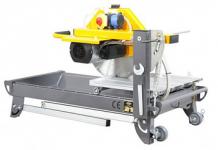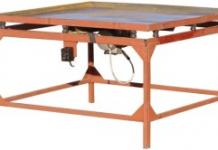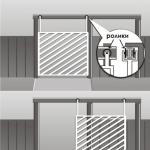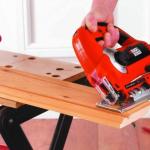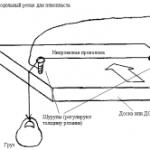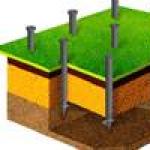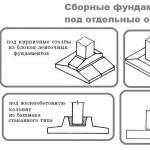Those who are planning to insulate an apartment or a newly built house with their own hands should definitely familiarize themselves with the methods by which foam plastic is cut at home, because this is one of the most popular and affordable methods of insulation.
Foam is a foam material and is mostly air, so it is very light and easy to work with. However, you should not think that no problems arise, because besides everything, foam is a rather fragile material. Therefore, if you use an electric grinder, you shouldn’t expect smooth edges, and besides, the entire room and area will be strewn with crumbled foam.
No matter how sharp the knife is, the material will still crumble. Of course, this is a minor defect and the sheets will be suitable for use, but cleaning will turn into a troublesome task. There is a way out of this situation; you can use a thermal knife. In this case, the edges of the material are melted and it does not crumble. But bad luck, such a device costs a lot, but in principle you can heat an ordinary knife. However, in this case you need to be very careful so as not to get burned, and the work will be significantly delayed.
For this purpose, you can use various cutting tools, for example, a grinder, only then you should use the thinnest disk. Very often, builders use a simple sharp knife. Sometimes it is advised to use a hacksaw with very fine teeth, but the latter method is very questionable. In addition, stores sell special thermal knives designed for working with foam plastic.
The thermal knife heats up to 600 °C in just 10 seconds. However, this tool is quite expensive, so it doesn’t always make sense to buy it.
The way out in many cases will be a device for cutting foam sheets, made independently. It is probably somewhat cumbersome, but if you have the necessary components, it is absolutely free and always available. And if you have to do large-scale work, for example, in front of you, which you built for your large family, then the question of how to conveniently cut the foam, and even a lot and quickly, will not come up throughout the entire event, no matter how long it drags on.
In order to assemble a cutter for foam plastic, you will need a tabletop, a pair of springs, M4 screws and 28 mm long stands, as well as a nichrome thread, which will act as a cutting tool. First, we make two holes in the base, press the posts into them, and cut a small groove at the base of the screw head, thanks to which the thread will be securely fixed in the given position.
When everything is assembled, we attach the string to the screws, but since it can sag during heating, it should be connected through springs, then the thread will always be in a tense position. The power source is connected to such a device using ordinary twists. This way you can make a homemade and very effective foam cutter, while spending a minimum of effort, time and money.
Trying to cut the foam yourself
Now let's talk a little about various technologies, methods and, of course, we will provide detailed instructions on what and how to do.
How to cut polystyrene yourself - step-by-step diagram
Step 1: Preparatory work
It doesn’t matter what kind of tool you are going to use - a knife, nichrome thread or other cutting devices, you still need to start with markings. So we take a ruler, a square, a tape measure, a pencil and make marks on the surface of the sheet, then we connect them into lines. In general, we draw the contours of the future section.
There are other ways you can. For example, using nichrome thread. In this case, a small current is supplied to it, which is capable of heating the string to the desired temperature, and cutting is carefully carried out along a given contour. Of course, the quality of the cut in this case will be much better, but you will have to work a little to make the machine. Therefore, this method is not always justified if you need to process only a few sheets; there is simply no point in spending time constructing a device. As you can see, it is impossible to give a definite answer as to what is better for cutting foam, it all depends on the volume and skills.
Foam plastic today is widely used as a sound and heat insulating building material, which has to be processed during the work process. In order for the sheets of material to correspond to the dimensions of the surface that is being insulated, they have to be cut. Cutting polystyrene foam can be done in several ways, one of which you can use in your work. The cutting process requires a certain approach for the reason that foam plastic can crumble and break if cut incorrectly.
Tools and materials
To work you will need:
- Styrofoam;
- ruler;
- pencil.
Return to contents
Methods for cutting foam plastic

Expanded polystyrene can be cut using a wallpaper knife. This tool will not only cost less, but will also be silent in operation, and cutting will be carried out in a short time. The advantage of this method is the minimal amount of waste.
Before you start cutting, you need to check how sharp the knife is. This characteristic of the tool will allow you to perform work faster and with better quality.
Foam with a greater thickness is more difficult to cut, and you should not use a knife for cutting if the thickness of the material exceeds 5 cm, as it will be ineffective.
A jigsaw will also not allow you to get an even cut line; in addition, there will be a lot of debris.
Before you start cutting, you should purchase a long saw: it will allow you to cut sheets whose thickness does not exceed 10 cm.

It is preferable to cut polystyrene foam with a hand saw designed for woodworking. If you intend to use a regular knife for the process, you will need to sharpen it before starting. Then the blade should be heated, only after that you can start cutting. In this case, cutting the material will be accompanied by melting of the edge. The cutting line will be smooth, the material will not crumble, and debris will be generated in minimal quantities.
You can also cut polystyrene foam with your own hands in an unusual way, which involves the use of hot nichrome wire. However, before you begin, you will have to do a little work on creating the tool. It can be made from wire, spring and transformer. The table must be installed at an angle of 60°. A wire has to be pulled across it; on one side, its end must be strengthened as rigidly as possible, and on the other, the end must be strengthened through a spring. To the ends of the wire you need to connect the wires of the transformer, which should be powered from the mains. After this, it is necessary to apply current and lay a sheet of heat insulator on the surface on top of the wire. Since the table is inclined, the thermal insulation sheet will move by sliding, succumbing to the influence of its weight.
To cut, you need to wait until the wire is almost red hot, but you should not let it get too hot. If this is allowed, the cut will become too wide. As the nichrome wire heats up, it will become longer. This indicates the need to use a strong spring in the design. This will allow you to adjust the length.

Cutting can be done with a grinder equipped with a metal disc. The thinnest disc should be used. This method cannot be called the most comfortable. In addition, the tool creates a lot of noise and a lot of debris will be generated.
Foam plastic lends itself well to processing with a soldering iron. The use of this tool will allow you to complete the work in the shortest possible time. The end of the soldering iron must be flattened with a hammer. After this, you need to put a special part on it, made of a blade and a steel cap taken from a fountain pen. The blade needs to be installed at the end. Then the soldering iron should be heated and you can start cutting the blades.
In addition to the fact that even sheets can be made from foam plastic, they can be shaped cutting, giving the workpieces a variety of shapes.
If you create shaped elements from foam plastic, the material can be used not only as insulation, but also as decor for any room.
Polystyrene foam is not afraid of staining, which is why its surface can be coated with paint after cutting. Each of the above cutting methods has its own advantages, but you should prefer the one that will be less difficult for you.
Sheet foam is insulation made from foamed polystyrene. In another way it is also called polystyrene foam. It is one of the most popular materials for thermal insulation of houses, as it is low cost and easy to install. But during installation of slabs it is often necessary to cut them. It is extremely important to make the cut of the foam sheet even, as large gaps can impair the thermal insulation properties.
Overview of methods
You can cut polystyrene foam at home using many methods:
- with a knife;
- hacksaw;
- jigsaw;
- grinder;
- electric knife;
- machine for cutting foamed polystyrene with wire.

1. A sharp knife is well suited for slabs up to 5 cm thick. The blade should be thin and not flexible, otherwise the cut will be crooked. To ensure even less waste when cutting polystyrene foam with your own hands, it is better to heat the knife. It should be taken into account that the blade will have to be sharpened approximately every 2 m, otherwise the work will take longer and there will be more debris.
2. You can also cut slabs with a greater thickness at home with a jigsaw and grinder. The main thing is that the height of the blade or disk is sufficient. The jigsaw must be moved smoothly, otherwise the polystyrene foam balls will begin to peel off from each other. It should be borne in mind that when sawing using these methods, the foam crumbles greatly.
3. A hacksaw for metal or wood is well suited for cutting polystyrene foam boards up to 10 cm thick. The finer its teeth, the better the cut. In addition, this cutting method is fast and does not require much effort. It is necessary to act smoothly and evenly, without sudden movements.
4. To prevent the foam from crumbling and to ensure an even cut, you can use a wire with a cross-section of 0.5 mm and stretch it between two handles. They begin to saw according to the markings and at the same speed. Due to constant friction, the wire will heat up and melt the foam. With this cutting method, the edges of the slab are smooth and even, and the amount of waste is minimal. The only drawback is that this work will require two people.
5. If you plan to cut a large number of foam boards, then it is better to purchase a soldering iron attachment or a special electric knife. Thanks to the sharp blade and high temperature, the slabs are cut quickly and evenly. In addition, they are used to make shaped cuts. But you need to take into account that the length of the blades of many tools is no more than 5 cm. Also, when working with hot tools, you should be careful not to get melted foam on your clothes or skin. It will not be possible to remove it from the skin instantly, which means there will be a severe burn.
6. Another good device that can be used to cut foam boards is a special machine. You can buy it or make it yourself. Cutting is fast, silent and effortless, and material of any thickness can be cut (depending on the capabilities of the machine). The amount of waste is minimal, and the cut is absolutely even and smooth. Another advantage of this method is that, thanks to the hot nichrome wire, the cut cells are melted back together. As a result, the thermal insulation characteristics of the foam do not deteriorate.

Before cutting the foam, you need to mark with a sharpened pencil. If possible, you need to cut the slab in the direction away from you. When sawing foam plastic using the heating method (machine with wire, electric knife), dangerous black smoke is released, which causes significant harm to humans. Therefore, cutting it using these methods should only be done in a well-ventilated area or in the open air.
In order to make a simple machine, you will need a surface with an inclination (20-60°). A nichrome wire with the required cutting height is stretched across it. One end of it is firmly fixed, and the other is connected to the spring. Then the wires from the power supply are connected. The current strength must be controlled so that the wire does not overheat too much, so a rheostat is additionally connected. The temperature should not exceed +100°C. After everything is ready and the thread is heated, the foam is cut. To do this, you just need to lay the plate down, and it will begin to roll off on its own (if the surface is smooth enough) or it will be pulled evenly through the wire. If you do this too slowly, the cut will be wide, since during this time a lot of foam will have time to melt. If you do it quickly, there is a risk of breaking the thread.
Ready-made machines for cutting polystyrene foam have more capabilities. With their help, 3D figures are made. Depending on the configuration, they can have from one to six strings. They are controlled either by an operator manually or through a computer program. Some are compact in size, making them easy to transport, which is extremely important for builders. The cost of machines for cutting polystyrene foam starts from 40,000 rubles. There are also models with laser - such devices make the highest quality cuts. Laser machines are used to cut out shapes for store windows, exhibitions or any other important events.
Before choosing the best way to cut polystyrene foam, you should decide how much material needs to be processed. If cutting will be carried out only once, then you can get by with a sharp knife or hacksaw. In another case, it is better to buy an electric knife or make a machine with wire yourself or purchase a ready-made one.
When carrying out work related to home insulation, you will not find a better material than polystyrene foam. It is popular because it is inexpensive and is a pretty good heat insulator. But when you get to work, a natural question arises: how to cut the foam and make the parts you need from it so that the cutting lines are straight and have the configuration you need.
There are two types of foam: hard, or also called hard, and soft. The hard type of foam is easier to machine (cut), which is why it is more popular. Soft types of foam crumble, and special treatment must be applied to them. There are also no foam sheets of uniform thickness, and it follows that the cutting modes will be different and require an individual approach for each case. The soft variety can be cut with any sharp, thin object, even a credit card. Place a ruler or straight edge along the cutting line and trace the line with your cutting tool. Then move the foam board so that the cut coincides with the edge of the table, and pressing the part of the board that is on the table, lightly press on the sagging part. The foam will break along the cut line. You can use a serrated knife from a kitchen set to cut foam. To make it more convenient to work, you need to rub it with a wax or stearin candle. If you need the foam to remain clean, use a white stearin candle. Cut the foam with even, long movements so that the knife is immersed with the entire blade. A paper cutter with a retractable blade works well for cutting thin sheets of foam. With this knife you can cut out different parts and fragments. First, make a cut not to the full depth, and then cut off the part you need using even movements. Make sure that the blade of your knife is always sharp, because if it is dull, you will not be able to make an even cut.





We have listed all the main methods of cutting foam, they are all good in their own way. Choose for yourself what suits you best.
Polystyrene foam is a universal material. It is used in construction (insulation), in the production (repair) of household electrical appliances, interior design, and advertising. One of the main characteristics of the material is density. The higher this indicator, the stronger the material. However, this greatly affects the price.
When using material as a filler for wall insulation, the loosest structure is usually chosen (due to low cost). However, loose foam is difficult to process - when cut, it crumbles heavily, creating difficulties when removing debris.
The knife for cutting foam must be thin and sharp, but this does not prevent the edge from breaking. Even if you work outside, flying small balls litter the environment.
Therefore, professional builders cut foam plastic using nichrome wire or a hot plate. The material is fusible, despite its fire safety.
Important! When choosing insulation, pay attention to the characteristics. It should say “self-extinguishing.” Such foam is perfectly cut using temperature, but in the event of a fire it will not become a source of combustion.
An industrial foam cutting machine can process sheets of any size and cut the material both across and along the massif.
However, cutting polystyrene foam at home does not involve such volumes and sizes. When carrying out repair work in your home (or garage), a compact thermal knife is quite sufficient. It can easily cope with both linear cutting and shaped fitting of slabs when laying in areas with complex shapes. 
Any tool has a cost, and there is always an opportunity to save on your purchase.
DIY tools for cutting foam plastic
The guillotine is perfect for linear cutting. Only the impact will not be mechanical, otherwise a lot of debris will be formed. We use proven technology - cutting foam plastic with a heated tension string.
Required materials
- Nichrome (tungsten) thread
- Power supply, preferably regulated
- Any construction materials: timber, metal profile, pipe, for making a tension frame
- Furniture drawer guides.
On a table, workbench, or other flat surface, we install vertical posts for attaching the guillotine. Using furniture guides, we secure the cutter frame so that it moves without distortion. Both sides must move in sync. 
The most important part of the cutter is the wire mechanism. The first question is: where to get the material. Nichrome can be purchased in stores selling radio components. But since we are striving for a shareware design, we will look for an alternative.
- Old soldering iron. Models made in the USSR, designed for 36-40 volts, can be found in any home workshop. The heater winding is an excellent donor for a nichrome guillotine. True, the length of the wire is no more than a meter.
- Iron with a classic spiral heater. The wire is thicker, suitable for linear cutting. Shaped cutting is acceptable, with low accuracy requirements.
- Spiral heaters from a hair dryer or fan heater. The principle is the same, they are not suitable for precise cutting.
note
Tip: When straightening the spiral, do not pull the wire along the spring. Loops may appear and the thread will break. It is better to unwind the turns as if from a spool of thread. You can put a spiral on a nail or pencil and pull the wire across the turns.
The principle of operation of the frame is shown in the diagram

The wire cutter must be electrically isolated from the frame. Therefore it can be made of metal. It is important to ensure constant tension on the wire. When heated, nichrome expands, adding up to 3% in length. This causes the string to sag.

